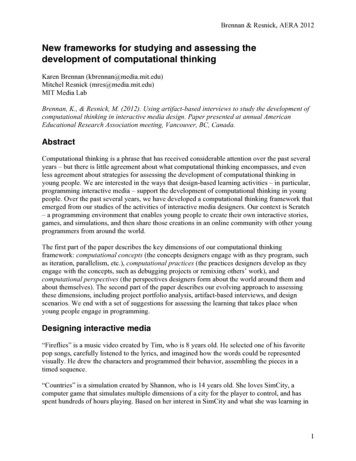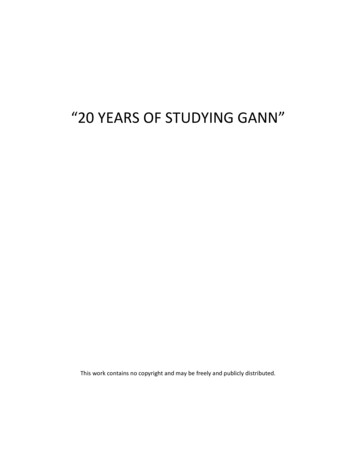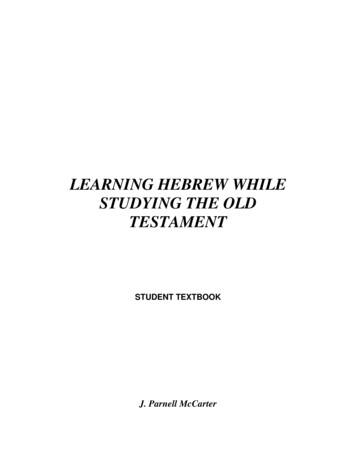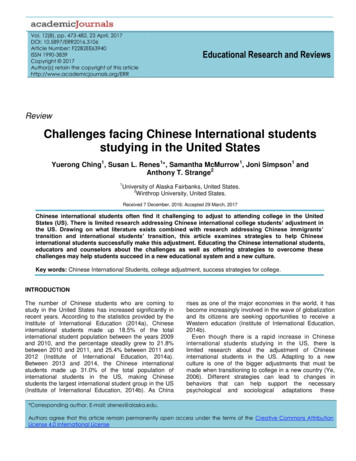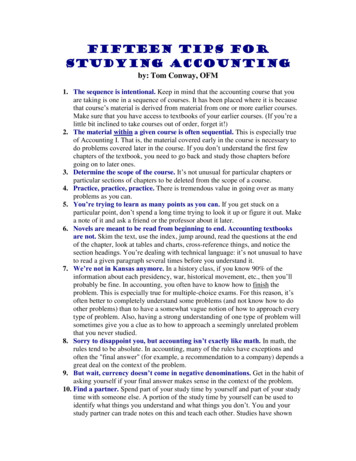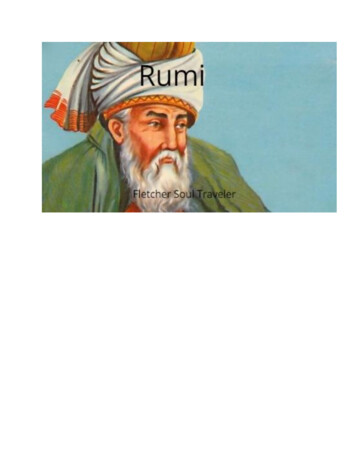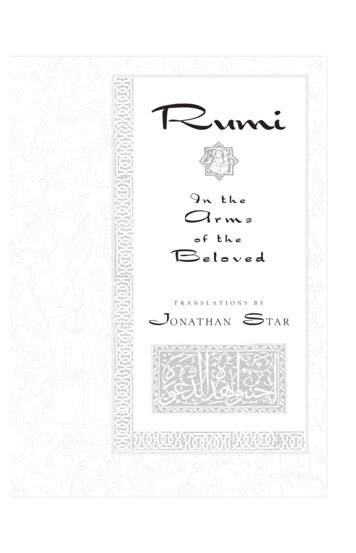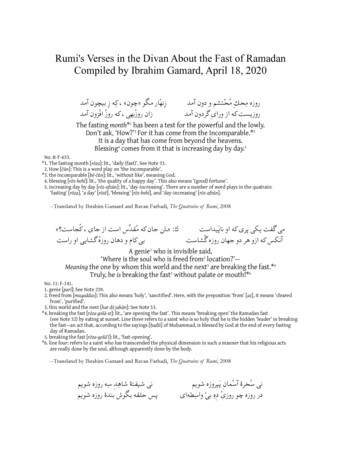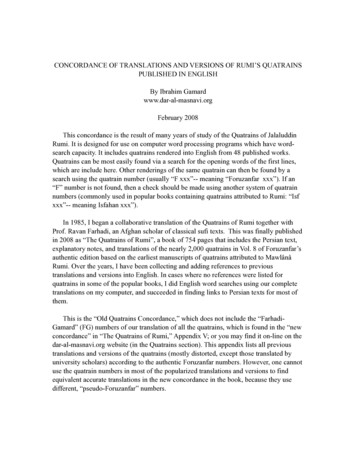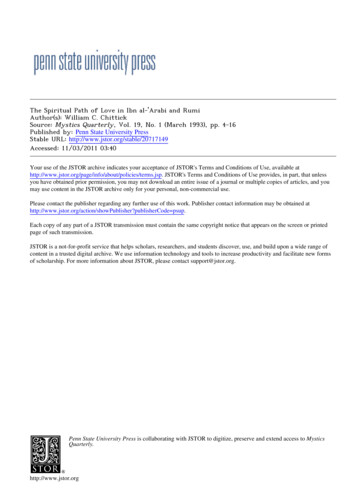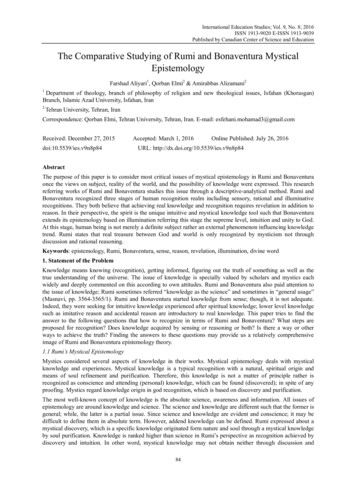
Transcription
International Education Studies; Vol. 9, No. 8; 2016ISSN 1913-9020 E-ISSN 1913-9039Published by Canadian Center of Science and EducationThe Comparative Studying of Rumi and Bonaventura MysticalEpistemologyFarshad Aliyari1, Qorban Elmi2 & Amirabbas Alizamani21Department of theology, branch of philosophy of religion and new theological issues, Isfahan (Khorasgan)Branch, Islamic Azad University, Isfahan, Iran2Tehran University, Tehran, IranCorrespondence: Qorban Elmi, Tehran University, Tehran, Iran. E-mail: esfehani.mohamad3@gmail.comReceived: December 27, 2015doi:10.5539/ies.v9n8p84Accepted: March 1, 2016Online Published: July 26, 2016URL: http://dx.doi.org/10.5539/ies.v9n8p84AbstractThe purpose of this paper is to consider most critical issues of mystical epistemology in Rumi and Bonaventuraonce the views on subject, reality of the world, and the possibility of knowledge were expressed. This researchreferring works of Rumi and Bonaventura studies this issue through a descriptive-analytical method. Rumi andBonaventura recognized three stages of human recognition realm including sensory, rational and illuminativerecognitions. They both believe that achieving real knowledge and recognition requires revelation in addition toreason. In their perspective, the spirit is the unique intuitive and mystical knowledge tool such that Bonaventuraextends its epistemology based on illumination referring this stage the supreme level, intuition and unity to God.At this stage, human being is not merely a definite subject rather an external phenomenon influencing knowledgetrend. Rumi states that real treasure between God and world is only recognized by mysticism not throughdiscussion and rational reasoning.Keywords: epistemology, Rumi, Bonaventura, sense, reason, revelation, illumination, divine word1. Statement of the ProblemKnowledge means knowing (recognition), getting informed, figuring out the truth of something as well as thetrue understanding of the universe. The issue of knowledge is specially valued by scholars and mystics eachwidely and deeply commented on this according to own attitudes. Rumi and Bonaventura also paid attention tothe issue of knowledge; Rumi sometimes referred “knowledge as the science” and sometimes in “general usage”(Masnavi, pp. 3564-3565/1). Rumi and Bonaventura started knowledge from sense; though, it is not adequate.Indeed, they were seeking for intuitive knowledge experienced after spiritual knowledge; lower level knowledgesuch as imitative reason and accidental reason are introductory to real knowledge. This paper tries to find theanswer to the following questions that how to recognize in terms of Rumi and Bonaventura? What steps areproposed for recognition? Does knowledge acquired by sensing or reasoning or both? Is there a way or otherways to achieve the truth? Finding the answers to these questions may provide us a relatively comprehensiveimage of Rumi and Bonaventura epistemology theory.1.1 Rumi’s Mystical EpistemologyMystics considered several aspects of knowledge in their works. Mystical epistemology deals with mysticalknowledge and experiences. Mystical knowledge is a typical recognition with a natural, spiritual origin andmeans of soul refinement and purification. Therefore, this knowledge is not a matter of principle rather isrecognized as conscience and attending (personal) knowledge, which can be found (discovered); in spite of anyproofing. Mystics regard knowledge origin in god recognition, which is based on discovery and purification.The most well-known concept of knowledge is the absolute science, awareness and information. All issues ofepistemology are around knowledge and science. The science and knowledge are different such that the former isgeneral; while, the latter is a partial issue. Since science and knowledge are evident and conscience; it may bedifficult to define them in absolute term. However, addend knowledge can be defined. Rumi expressed about amystical discovery, which is a specific knowledge originated form nature and soul through a mystical knowledgeby soul purification. Knowledge is ranked higher than science in Rumi’s perspective as recognition achieved bydiscovery and intuition. In other word, mystical knowledge may not obtain neither through discussion and84
ies.ccsenet.orgInternational Education StudiesVol. 9, No. 8; 2016studying nor sense and experience; rather, it is only possible through conduct and inner purification; thus, it isconsidered as the highest rank knowledge and recognition. Rumi believes that human being reaches to the levelsenabling him perceive many facts including divine attributes by heart through mental evolution and acquisitionof spiritual virtues.In spite of the five senses; the spiritual sense observes both worlds(Masnavi, 3551/2)1.2 Knowledge Means or WaysMystics and theologians almost agree on the issue of epistemology since they believe in the reality of theuniverse and its numen; they also believe in truth existence meaning that the universe is not only the reality butalso it may overcome by human awareness and science; the universe is recognized and reality relevantperception is fixed and permanent. Scholars are divided in to two groups in term of recognition tools:mono-tool and poly-tools groups. Positivists believe that recognition tools merely contain sense and sensory data.Plato and peripatetic philosophers only rely upon reason; whereas, illumination philosophers consider the heartand soul as recognition tools. In Rumi’s opinion, revelation is a recognition tool, too. However, some mysticsview the heart as the only mean of knowledge “the heart is the mean of god knowledge acquisition and divinesecrets” (Afifi, 2001; 193). Senses, reason, heart and revelation are known as recognition means in Rumi’sattitude each requiring special consideration. The universe is divided into two worlds of command and creationin term of nature, each with its own characteristics. Senses and reason are the mean to recognize the creationworld; whereas, the soul (heart) and revelation are the command world recognition means, each stated inMasnavi. However, the most comprehensive knowledge expressed as command world recognition, which ismerely acquired through heart and revelation. Therefore, it is necessary here to explain these means in short.1.3 Sensory Recognition and KnowledgeSensory awareness and knowledge is incomplete and inadequate. Rumi stated that relying upon sense hindersachieving to real science; he believed that surface sense only perceives a limited part of the surface reality due tothe existing constraints; in a simple analogy, it is like the hand touching the elephant in a dark room to imaginethe elephant body. In this story, “elephant” is a metaphor of oversoul and “darkness” refers to this mortal world;further, “those touching the elephantine body” are metaphor of individuals seeking for the oversoul to be knownby their narrow, inadequate experimental and intellectual scales; and finally, the “candle” represents the light ofcertitude and intuition such that whenever an individual is exposed to such shining the truth may be uncovered.The concept of this story reveals that people differences resulted from different attitudes and partially-orientedinterpretation providing conflicting areas that is why mystics hate form and term. The visual, external sense onlytouches the appearances ignoring the truth root. Rumi thinks that the whole recognition and knowledge acquiredif human senses are enlightened by God knowledge bright light.You know how a clear sense feltThat is by the enlightened sense of God light(Masnavi, 2634/1)As Rumi states, sensory perceptions are similar to dirt and dust over the soul curtaining reason eyes such that thereason is unable to see the spirit (Masnavi, 1826/3).Undoubtedly, external sense is the necessary mean of recognition, since there would no recognition obtained ifhuman being lacks senses. Rumi is certainly aware of this case; however, he regards surface, external recognitioninadequate. Rumi thinks that in the case of sensory recognition is beyond animal perception; it required beingalong with intuitive and rational reflection (Masnavi, 48/2).Rumi also distinguished five other internal senses in addition to these five external senses, which are highlyvalued; he believes that external senses feed on darkness; whereas, internal ones live on the truth and reality(Masnavi, 49-53).1.4 ReasonReason is of a very special place in Rumi’s perspective, which is highly effective and efficient in understandingother concepts of his epistemology model. He defined a hierarchy for reason with predetermined boundaries. Thereason, as Rumi believes, is to know the truth and to distinguish the right and wrong as far as this continues itmay never be condemned rather it is realized as the necessary means of human life. Fundamentals of Rumi’smystical idea are formed by knowing the levels of reason. According to some evidences, Rumi divided thereason in to two types: partial wisdom and total wisdom. In other word, Rumi separated two kinds of knowledge85
ies.ccsenet.orgInternational Education StudiesVol. 9, No. 8; 2016including partial knowledge and total knowledge. Partial knowledge comes from senses and theoretical reasoncomparing to total knowledge, which is derived by intuition, soul purification and evolution.1.4.1 Partial ReasonPartial reason is the very individual mind in all human beings limited to sense and imagination world (Masnavi;3311-3315/4). Partial reason lacks the ability of understanding the reality mysteries and wonders since it islimited to tangible world. Rumi viewed partial reason indecent as it is superficial, self-thinking and captured bythe passion (Masnavi; 119-120/6).Partial reason is like a flash of lightening only illuminates a certain range of facts; while, this range is far fromthe absolute perception, which is interpreted as “Vakhsh” (Masnavi; 3319-3323/4). Rumi permanentlyemphasized on the negative aspect of partial reason, which is like a veil and limitation incapable of achievingdivine truth (Masnavi, 463/5).1.4.2 Total ReasonTotal reason sees the internal and serves as god servant; further, it takes human to the peak. The total reason isthe primary essence created by God “God initially created the reason” (Forouzanfar, 1982, p. 31).The holy God initially created the reason more than anything else in the two worlds (Masnavi; 1936/6)This world is a thought of total reasonThe reason is the king and the forms are its messengers (Masnavi; 978/2)In Rumi’s word, this world is a thought of the whole reason such that all creatures manifested through wholereason (Masnavi, 3259-3263/4).The general wisdom is a divine gift bestowed upon to human being. As earlier mentioned, total reason is theworld fundamental and all internal faces of human and the universe are manifestation of this mind. “In otherword, the general reason is the total expressive wisdom surrounding all things and properly perceives all facts”(Homaie, 2014; 469). The total reason is like a broad and wide sea in which the forms and possibilities arefloating like bowls. Rumi analogized the form to the bowl and the truth to the sea; as long as the bowl is notfilled it stays on the surface; whereas, it is drowned whenever it is filled. Therefore, to get the truth it deserves topass the forms and symbols (Masnavi; 1109-1112/1).1.4.3 Faith ReasonIn Rumi’s perspective, faithful reason is the justice city constable ruling and capturing the hearts and eliminatesany uncertainties. It is analogized to a smart cat that the burglar is like a frightened rat hiding in the hole. Theburglar is the very inspired nafs (an-nafs al-ammarah) unable to show off and flaunt in spite of the faith reason.Once the passion and erotic desires overcome the faith reason it leads to the knowledge and recognition bywhich the human being finds a way to God. However, if the human being lacks the faith reason, the inspired nafswill prevail hindering the real knowledge and recognition (Masnavi; 1086-1991/4).1.5 Internal Intuition or the Way to the HeartRumi considers the issue of spirit as the reality intuition through inner purity “the inside is the road to the truthgoing through human; this road is characterized with honesty, purity and avoiding moral vices” (Ibrahimi-Dinani,2010; p. 59). Rumi stated the conditions of knowledge achievement by heart as follows: patience on worship(Masnavi; 71/2), approaching to mortality and survival (Masnavi, 1474/2), leaving the passions (Masnavi,3749/3), as well as attachment of partial soul to the total divine soul.Once the partial soul is enriched by the whole soulAll the existences benefited (As the world serves as the corpse to the perfect human, and the perfect human is likeits soul) (Masnavi; 1190/2)The truth is human idealistic giving the seeking motivation to him; the philosopher tries to reach the truththrough reasoning; whereas, the mystic attains the truth through intuition (Masnavi, 1357/4). In Rumi’s attitude,the heart is the divine occult quip embracing human truth (Masnavi, 3575-3577/1); he thinks that the pure, clearheart (soul) as a mirror reflecting all attributes of God; once the heart is rusted with velleity it avoids reflectingdivine secrets and truths; whereas, the pure-hearted human manifests divine truths (Masnavi; 34/1) (Masnavi;2909-2910/1). The pure heart is “the mean by which not only the knowledge of God and divine mysteries, butalso knowledge of all embraced under the title of inside science may achieve” (Afifi, 2001; p. 193).Molana defined the real knowledge as intuitive or illumination-based and heart observation-based knowledge;86
ies.ccsenet.orgInternational Education StudiesVol. 9, No. 8; 2016moreover, the best and most comprehensive recognition way is revelation. Revelation basically relies upon heart.Rumi’s intuitive knowledge is characterized with direct perception (Masnavi, 122/1), it cannot be compared toanything (Masnavi, 2812-2814/3), it is non-descriptive with universally and pervasively presence (Masnavi,760-761/1) (Masnavi, 1552/5). According to Rumi, the critical mean of knowledge revelation and intuition aswell as attaining heart knowledge is love; on the other side, love results from intuitive knowledge, too. This isthe love supporting the wayfarer along the knowledge road; and of course, the love deepens in meeting each step(Masnavi; 2192/5) (Masnavi; 1532/2).2. RevelationRevelation is the word that is latent to human physical sense perceptions. Sometimes revelation is used in itsgeneral implication including revelation of heaven, bee, common people, and messengers. In the story of Abeland Cain, when Cain desperately wondering how to get rid of Abel bloody corpse, a crow, bestowed divineinspiration, sent to him by God so that to instruct him how to bury the dead body (Masnavi; 1304-1307/4).Mulavi repeatedly mentioned to the cases where God communicated to non-prophets such as uncoveringChinese prince secret explained in the sixth book:Following much searching, finally the wised Sheikh discovered that secretThe secretes were uncovered to him not through hearing and physical ear; rather, inspired by revelation(Masnavi; 3787-3788/6)The most important revelation is assigned to the great prophets; it is not weighted and understood by physical(material) issues; further, it may never be described. According to Rumi, the words are unable to express it(Masnavi, 1775-1776/2).In Mawlānā’s attitude, the followers must seek the instructors and conductors since it may not be possible toreach the destination without any direction and guidance as the conduct lacking total guidance is based onsuspicion; whereas, the messengers are undoubtedly talented by God. Revelation is proofed and highly authenticas it is received by Allah (Masnavi, 4100-4105/6).Revelation as one way of truth recognition is available to all human beings. Mawlānā believes that revealing thetruth of revelation requires benefiting the revelation itself (Masnavi; 3258-3263/2).3. Basics of Rumi’s EpistemologyRumi’s epistemology regarded as a mystical epistemology. He stated that “partial knowledge are the product ofsenses and general, visual reason; whereas, the total knowledge resulted from intuition, nafs purification andmental evolution” (Jafari, 2008, p. 35).Regarding to Rumi’s mystical epistemology, there is no certainty and truth imagined for partial (minor)phenomena; rather, the true knowledge is defined under the light of holistic view and linking the worldcomponents. Rumi attributed the difference in recognition to atomistic view and believed that thesecontradictions come from this truth that any individual perceives the universe as much as he figures out by itsown insight and way (Masnavi, 2368-2370/4).Of Rumi’s epistemological basics is the objects’ returning to God such that the objects return to the origin wherethey have come from.The components tend to the total like the lover who has the great affection for the beloved(Masnavi; 763/1)What goes from sea to sea, exactly destined to the original departure(Masnavi; 767/1)The ultimate objective of Rumi in epistemology is to cross the surface into the inside, from the form to themeaning; he regards the inside science causes human prosperity. Its epistemology is based on Islamic principlessuch that he highly referred to koranic verses and traditions. Rumi stated that the real treasure of the relationbetween God and world is only recognized through theosophy and mysticism rather than through rationalargument.All creatures belong to Him as if it is impossible to imagine no dependencyEverything is rooted in the separation and attachment (Masnavi; 3695-3696/4)Rumi calls God the world’s soul and spirit; in other word, God is attributed as the existence essence, the elegance,and the living treasure in the universe that always exists and survives; if anybody is attached to this prevalent87
ies.ccsenet.orgInternational Education StudiesVol. 9, No. 8; 2016treasure, there would be no more concern of loss and benefit. This attitude basically constitutes the fundamentalsof Rumi’s epistemology.You are like the world spirit to me; why shall I concern for othersYou are like a prevalent treasure to me; Am I supposed to think about any loss and benefit?(Dīvān-e Šams; 162)4. Mawlānā’s Epistemology LevelsMawlānā also determined three levels of epistemology following mystics including religion, creed and truth; andexpressed sub-principles for each category. In the fifth book introduction, he stated that “the religion enlightensthe road like a candle. The way is not traversed unless by a candle; then, you are on the creed road. And finally,you approach to the destination, which is the very truth”. In Islamic mysticism this trio classification is anotherinterpretation of the appearance and essence, which are longitudinal rather than phenomenal. Disregarding thelongitudinal hierarchy of these three levels led to some difficulties in understanding Masnavi. According toMawlānā’s mystical idea, these three realms may never be separated. In his attitude, observing the religion is anecessity for the follower such that the religion, creed and truth are the unitary verity that the prophets and greatmystics including Rumi always interpreted and preached (Masnavi, 1394-1397/1). Rumi believes thatrecognizing universe requires drawing the surface curtains in order to approach to the essence (inside); inaddition, he calls the universe inside as monotheism. Rumi’s world is the world of mystery, which is not easilyuncovered; it requires an enlarged heart and soul as well as several knowledge efforts to be understood.5. Bonaventura Mystical EpistemologyBonaventura distinguishes three steps of recognition realm for human: sensory, rational and illuminativerecognition. Bonaventura knows rational faculty as the dominant force in human being; furthermore, accordingto his view, the reason is not the adequate condition of recognition; rather, he believes that approaching to truerecognition (knowledge) requires having revelation next to reason; moreover, he also focused on the central roleof Christ and word of God in recognizing the truth. Bonaventura extends his epistemology in term ofillumination and refers this step under the name of the supreme stage of intuition and union with God.5.1 Sensory KnowledgeBonaventura considers the sensory knowledge as the lowest level of recognition dependent on sensoryperception; and the sensory perception is the act of breathing utilizing sensory organs as its means. “Breathingimposes its sensory functions through sensory organs as far as it grants life to body. Sensory recognition firstlycontains an action imposed by an external object and influenced by a sensory organ” (Gilson, 2010, p. 473).Bonaventura believes that nafs owns some force (faculty) in which any force individually performs the particularepistemology. He also thinks that perception is both active and passive; external senses receive tangible data;whereas, internal senses (common senses, imagination and memory) link and judge them. RegardingBonaventura opinion, innate ideas are abstracted from a sensible case. On the contrary to Plato he does notbelieve recollection theory in recognition issue; rather, recognition began by a tangible thing and nafs isanalogized to a simple drawing prior to sensory recognition. However, it may not be true about God as it ispronounced as a totally innate idea. In Bonaventura point of view, human nafs is the essence exists perse and is aunitary and incorruptible thing in spite of keeping its material and form. Material in human nafs is a spiritualsubstance created along with a form; hence, since this is also a spiritual form, “nafs is also considered absoluteliving as a spiritual creature” (Quinn, 1973, p. 140). Regarding to the combination of material and formintroduced by Bonaventura, it is necessary to mention that material is used for creatures not because of theirphysical existence; rather, as they are living beings. This is the only approach to figure out the well-knownperspective of Bonaventura and Franciciyan on the composition of matter-form of spiritual treasure. However,the material is a set of possibility conditions; for instance, it is always in a particular place, occurred at aparticular time and always exposed to motion and rest. The material is never detached from its form; rather, theessence creates these distinctions. Thus, “once the material is viewed in term of its existence it will be alwaysregarded as unified” (Pegis, 1983, p. 35). Bonaventura concluded that since the material is a passive, receptiveforce (faculty), it is necessary to place such material inside the nafs. Bonaventura began its epistemology bysense; however, the knowledge structure passes the evolution steps such that the human being initiates itsknowledge with a partial sense and gradually activates the general (total) concept potentially existing in thatsense. Accordingly, it also exists in the sensible forms of tangible objects; though, it may never be stopped atsense step. The surface senses (visual senses) are followed by common sense such that all senses approach to acommon sense inside human being. Sensory knowledge is the primary knowledge only by which you get to88
ies.ccsenet.orgInternational Education StudiesVol. 9, No. 8; 2016know the world; such knowing is fleeting, incomplete and with errors. The next step is the rational perception.5.2 Rational KnowledgeBonaventura like Aristotle maintained two forms for reason one is the Agent Intellect and the other is thePossible Intellect. According to Bonaventura, agent and possible intellects distinguished in term of reasonfunction rather than in term of the essential differences. He never discriminates the reason; rather, he considers aunified, single essence for reason.Indeed, human being has one reason representing two different aspects in term of act meaning that there is nosubstantial and existential discrimination made between agent intellect and possible intellect; on the contrary, itis differentiated based on epistemology i.e. the difference inspired by reason action aspect. “Since Aristotlevalues the agent higher than the possible and the origin predominates the matter. The active intellect embracesthe reason related to passive intellect; however, this intellect essentially is non-passive.” (Davoudi, 2015; 99)According to Bonaventura, no discrimination seen between active and passive intellect; indeed, bothcomplement together such that an interaction seen, which leads to recognition and knowledge. “Passive intellectis given the power of abstraction and statements’ judgment by the aid of active intellect; moreover, the activeintellect requires the passive intellect data to recognize” (Copleston, 1985, p. 284).Bonaventura epistemology model states that the truth is an eternal, unchanging and constant phenomenon suchthat this truth is neither discovered in human nor the outside world. In order to obtain unchanging truth, the mindrequires being infallible, which is evidently impossible for human mind. So, now what shall we do? How wemay achieve the necessary and unchanging truth? The solution proposed by Bonaventura is taking the benefit ofdivine intellect and illumination. In this regard, Bonaventura rationality is illuminative; he considers the supremeright over the human being; acquiring the supreme right requires human being released flying toward realintellect.5.3 Reason and RevelationBonaventura believes that the reason alone cannot provide a complete understanding of the world; rather, itneeds to be accompanied by faith. He stated that our beliefs are indebted to authority and our perceptions owedto reason such that the beliefs achieved based on revelation and prophet tradition. In fact, “he insisted that nosatisfactory philosophical and metaphysical system may be created unless the philosopher directed by the light offaith and sought for philosophy under the light of faith” (Copleston, 2011). In other word, Bonaventura agreedupon quote supremacy over reason and perception nature by faith; this is viewed as the best way of attainingabsolute knowledge. Bonaventura expressed that real recognition is merely acquired through revelation and Godillumination; further, no truth recognized without God realization. That is where Bonaventura introduced whattranscendent wisdom and Islamic mystics seriously highlighted. Bonaventura offered several ways of getting thetruth first of which are all verified; secondly, are consistent, and thirdly, they complement each other. Thus,according to this epistemology model, reason and revelation considered the two ways of truth and recognitionachievement; they show harmony and relevance; in addition, no contradiction and inconsistency seen. Reasonunderstands the religion and serves as a mirror reflecting God tradition. “God must be named as our instructor,since our mind perceives relying upon him. He is like the light source for our mind and is the principle by whichany truth realized” (Lin, 2011). Augustine’s followers including Bonaventura believed that reason requires Godassistance, which is released to him by revelation.6. Recognition by IlluminationBonaventura believes that “reason alone cannot recognize” (Hayes, 1987, p. 1013); therefore, he regardsillumination as the highest level of recognition and extends its epistemology by this. Bonaventura referred thisstep as the supreme level of intuition and union with God. Such knowledge is not acquired; rather it is thepresence, attending knowledge, which is received. At this level, Bonaventura introduces “the issue of Godeternal wisdom or samples” (Kent, 1998, p. 833). The difference between illumination and former recognitionsteps is that the human being in this realm is not merely the identification subject; an outside, external thinginfluences the recognition trend. The divine light reveals the facts beyond intellectual human thoughts and leadsto a direct encountering between human and those realities. Human being gets its recognition at illumination stepwhere the reason is passive. Whereas, in “recollection theory, human reason is active acquiring the reality.However, illumination theory corresponds to Plato recollection theory” (Cullen, 2006, p. 78). Bonaventuraintroduces the conduct as the mean of truth achievement focused on approaching to God rather than itsrecognition. The illumination theory of Bonaventura must be interpreted under the shadow of two centralperspectives including exemplarism and abstraction. Indeed, “Bonaventura defines a knowledge role for89
ies.ccsenet.orgInternational Education StudiesVol. 9, No. 8; 2016illumination not a merely emotional role” (Cullen, 2006, p. 80). Bonaventura indicated that the constant, rationalthing is only understood through abstraction; thus, we require God illumination. According to Bonaventura,objects’ truth may not be revealed unless they are enlightened. This divine light inspired by God, which giveslight to the reason is the rational light brightening everything. Eternal truths rooted in God illuminated to humanreason from a source beyond the reason. It is evident that in such attitude, truth realization may not be possiblethrough mere reason as God does not belong to the thought and idea; rather, it is a will manifested in therevelation. He is the source of any recognition such that the reason is unable to recognize the truth lacking divinelight. Bonaventura thinks that “mind directly forms its ideas in accordance to the ideas realized in God truth;therefore, they are acknowledged” (Schumacher, 2009, p. 19). Realities appeared within mind naturalillumination process assigned to knowledge. Bonaventura says that recognition acquired when the human beingis tended toward God, gets rid of sins and persistently keeps on.Bonaventura leads knowledge toward “a mystical union with divine love” (Everton
and soul as recognition tools. In Rumi’s opinion, revelation is a recognition tool, too. However, some mystics view the heart as the only mean of knowledge “the heart is the mean of god knowledge acquisition and divine secrets” (Afifi, 2001; 193). Senses, reason, heart and revelation
